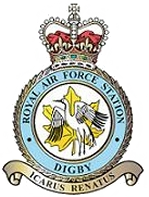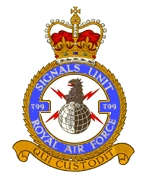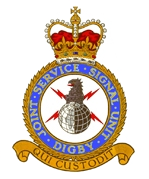RAF Digby

If you look at Roy's Service timeline you will see that he was frequently serving at Royal Air Force Digby, and in particular the No. 399 Signals Unit there.
RAF Digby is a station in central Lincolnshire (England). It became a Royal Air Force station in the same year as the Royal Air Force itself - 1918. In WWII it served as a Royal Canadian Air Force base from 1942.
Digby is also the home to a reconstructed World War 2 sector operations room and this is open to the public.
The Ministry of Defence website records that Royal Air Force Digby is the oldest operational RAF station and its flying history spanned 35 years. Originally called RAF Scopwick, it was established on 28 March 1918. It has been home to a number of units, including Nos. 2 and 3 Flying Training Schools and both Guy Gibson and Douglas Bader were stationed here. In 1942, the station became a Royal Canadian Air Force Station operating Mosquito aircraft.

Following a brief period as a technical training unit, the role of the station changed yet again in 1955 with the arrival of No. 399 Signals Unit. It was to 399 SU that Roy would return again and again. It was his trade's home unit and as a small specialist trade, personnel would often find themselves working together at 399 SU or one of the other few similar signals units around the world. 399 SU was later joined, at Digby, by 591 Signals Unit and the Aerial Erectors School. No. 399 Signals Unit changed its name to the Joint Service Signal Unit (JSSU) on 15 September 1998, reflecting not only its tri-service environment, but also its bi-national one with members of all three US forces serving alongside RAF, Army and Royal Navy personnel.
On 1st April 2005 the Unit merged with the rest of the station to become the Joint Service Signals Wing (JSSW) Digby. Yet on 1st August 2008 the Unit changed its name back the the Joint Service Signal Unit (D)
Today RAF Digby has a significantly different mandate than it did when operating as a key operational airfield during the Second World War, however it's current role has never been more critical. From an outsider's perspective, Digby may appear to be a sleepy hollow in which nothing much happens; however, this could not be further from the truth. The station supports both strategic decision makers at the highest level and the front line on a 24/7 basis, directly supporting our Armed Forces wherever deployed. As such, the station has to be able to adapt to an ever-changing security environment and embrace technological change to remain capable of meeting our remit.

JSSU (D) is an MOD sponsored unit whose mission is to provide operational support to the development of specialist communication information systems. JSSU (D) is the largest of several Joint Service Signal Units, and as its name implies it comprises personnel from all 3 UK and US Armed Forces, supported by specialist civilian staff and contractors. However, the RAF and the Army together make up most of the 500-strong complement.
In carrying out its mission, JSSU (D) operates both at home and on deployments overseas. In this regard, the unit carries out its own military and specialist training which ensures that individuals earmarked for such deployments are well prepared and able to look after themselves in the field.
JSSU (D) links with other national and international organisations, such as the US military, NATO, and other government departments, to ensure that communications capability is consistent between all users.
Tony Cunnane's memoires record his time at Digby
More History:
The flying history of RAF Digby spanned 35 years from Mar 1918 to Feb 1953. In the early days, the sky above the airfield reverberated to the sound of Handley Page 0/400, Avro 504 and FE2b machines. These subsequently gave way to a multitude of biplanes in the 1920s-1930s and eventually to the roar of Rolls Royce Merlin powered RAF Fighters in World War II. The airfield also witnessed the arrival of the jet age when two Gloster Meteor Fighters operated from the grass airfield in Jul 1945. Flying ceased in Feb 1953, after this the Stn continued to be a key contributor to the defence of the United Kingdom with the arrival of 399 Signals Unit and 591 Signals Unit.
Royal Air Force Scopwick opened on 28 Mar 1918 as a satellite airfield for RNAS Cranwell and the Cadet College of HMS Daedelus. The first Stn Cdr, Maj John D'Albiac DSO, a Royal Marines Officer, was subsequently made Sqn Ldr on the formation of the Royal Air Force on 1 Apr 1918. In Nov 1918, the Stn became an independent Unit with the arrival of 59 Training Depot Stn (59 TDS) the role of which, was flying training for Officer and Airmen Aircrew on both bomber and fighter aircraft. In Apr 1920, RAF Scopwick was renamed, due to a continuing mix up with RAF Shotwick, to RAF Digby. Renamed, the Stationn received a new Stn Cdr in the guise of Sqn Ldr A T Harris AFC RAF; later to become AOC in C of RAF Bomber Command in 1942 and one of the RAF's greatest wartime Commanders and better known to most as 'Bomber Harris'. With the arrival of Harris came No 3 Flying Training School (3 FTS).
Following a period under "Care and Maintenance" 1922-1924, the Station was re-activated in 1924 with the arrival of No 2 Flying Training School, commanded by Wg Cdr Sidney 'Crasher' Smith; so named for his heavy landings! The new Stn Cdr was then Wg Cdr A W Tedder, later to be Lord Tedder. During the tenure of the latter, Sgt Snaith QFI of 2 FTS won great fame and prestige by being the only Airman Pilot entrant in the 1926 Duke of York Cup Flying competition and winning the event against the very best the RAF could muster. In the following year he gained another first, alongside Sgt Lowdell, by becoming the first Airmen's Pilot in RAF history to obtain A1 categories as Flying Instructors.
The role of flying training continued throughout the 1920s and 1930s using newer and faster biplane aircraft, ranging from Sopwith Snipe, Bristol F2B, DH7, DH9, Avro 504K/N, Armstrong Whitworth Siskin, Armstrong Whitworth Atlus and Avro Tutor. With war looming RAF Digby departed from its previous role and became a Sector Fighter airfield within 12 Group, RAF Fighter Command on 13 Aug 1937. In Nov 1937, 46 Sqn (Gloster Gauntlet) and 73 Sqn (Gloster Gladiator) arrived as the resident Fighter Squadrons. Within the year, both had re-equipped with the Hawker Hurricane Mk1. When war came on 3 Sep 1939, RAF Digby was home to three Hurricane Squadrons, 46 Sqn, 73 Sqn and 504 Sqn. On 4 Sep 1939, 73 Sqn was sent to France and in May 1940, 46 Sqn went to Norway but not before engaging an enemy Squadron of Heinkel 115s off the coast of the Humber and shooting down five into the sea. Following this action, the King, His Majesty King George VI, visited RAF Digby on 13 Nov 1939. The Stn became home to day and night Fighter Squadrons and each played their part in the defence of the skies over Great Britain. Many famous Aviators served at RAF Digby, they include Fg Off Edgar James 'Cobber' Kain, Fg Off Bob Braham, Flt Lt Guy Gibson, Sqn Ldr Charles Widows, Flt Lt Jean Offenburg, Wg Cdr 'Johnnie' Johnson, Wg Cdr Lloyd Chadburn, Flt Lt Josef Frantisek and many, many more.
In Sep 1942, the Stn became Royal Canadian Air Force Digby with satellites at Wellingore and Coleby Grange. The sorties flown included defensive air patrols by day and night, escorting bombers, 'Rhubarbs' attacking enemy ground targets in Europe and in 1943 night fighter missions over Europe in support of RAF Bomber Command operations. When VE Day came on 8 May 1945, the Station had been the wartime home to 30 RAF Squadrons, 13 Canadian Squadrons, 4 Polish Squadrons, 2 Belgian Squadrons and 1 Czech Squadron and flown Hurricane, Spitfire, Defiant, Blenheim, Beaufighter, Mosquito, Mustang, Wellington, Oxford and Anson aircraft. It had hosted the full range of visiting RAF heavy bombers and their crews, as well as no fewer than 54 USAAF B-17Gs in Nov 1944!
By the end of the war the Station had returned to the RAF and was handed over to Technical Training Command with a number of Trade Training schools arriving. By 1953 most of the schools had relocated elsewhere and the Station went on to a short period of care and maintenance until work started on 1 October 1954 to receive 399 Signals Unit and thus began yet another new chapter in the Station's history.
The Station continued to expand steadily throughout the 1970s, 80s and 90s. The arrival of the Army, initially in 1994, and later the Royal Navy and the US detachments, signalled the start of yet another era in the history of Digby. On 1 September 1998 399 Signals Unit merged with the newly arrived Special Signals Support Unit from Loughborough to form the JSSU(D). JSSU(D) merged with the rest of the station on 1April 2005. Digby is not only a truly tri-Service environment but has a distinctly multi-national flavour to it, one that evokes memories of the last time the Station hosted overseas personnel.
The aviation heritage of RAF Digby and its satellite Stns, spanning 1918 to 1945 is recorded and preserved within the RAF Digby Sector Operations Room Museum, which has been refurbished and restored to its appearance in Sep 1939. The Ops Room, which provides a fitting tribute to Digby's wartime heroes, was opened in May 1997 and is open each summer May to Sep, or by appointment.
Over the years the Station has not only enjoyed excellent relations with the local community but has also played an active part in that community through participation in various initiatives and projects as well as entering sports teams into local competitions. In particular the Station enjoys a close relationship with the town of Sleaford.
Links:
- http://tonycunnane.uk/page-389.html < With Tony's passing this website no longer exists, but you can read the relevant pages here.
- A Life story incl. time learning the trade at N.Luffenham (Linguist)
- RAF Digby (Wikipedia)
- RAF Signals units (Wikipedia)
